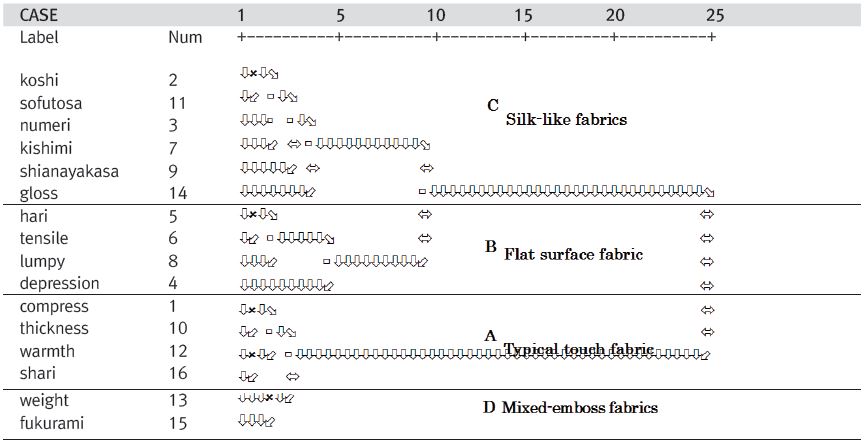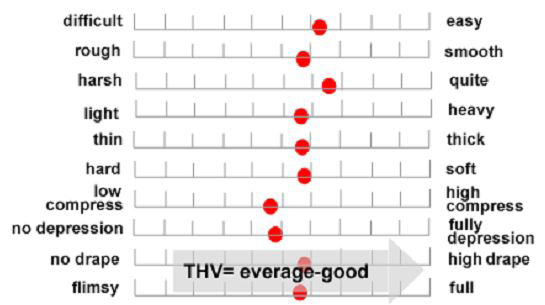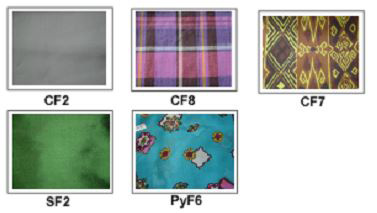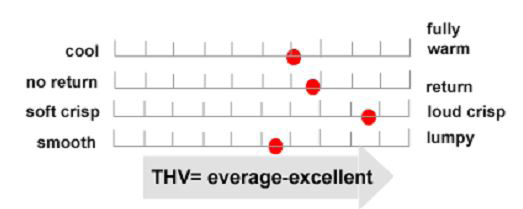
Kansei: The Creative Mind In theVisual Analyzing Process
Abstract
Background Emotions are complex conscious states that play an essential role in our daily lives. They have a great influence on human perception, particularly concerning our thinking, learning and decisions. In design, product emotion plays an important role in encouraging product quality and sustainability. Several methods and tools exist and are used to in the process of evaluating users-emotional experiences with products. Emotion is important to design because virtually all the decisions we make are based on how we feel or how we anticipate we will feel. Kansei engineering is a consumer-oriented technique for new product development. In product design, for instance, clothing and fabric design can be applied to translate consumers’ favorite feelings or images into physical design elements.
Methods This paper aims to develop the process of evaluating users’ emotional experiences in a more accurate semantic dimension through Kansei. Image feature extraction is a key issue for concept recognition in images and particularly emotions. In analyzing the product images, KJ methods based on the affective model was used to develop the full range of emotional keywords. This method shows the potentiality, limitation and building of a new framework for understanding the semantic structure used by designers in the visual analysis process for fabric analysis of clothing. Another affective model from SD methods also needed to support all the data.
Result The results show that various methods of the affective model will be a good reference for design studies that are involved with users’ subjective emotional experience with product design. The emotional expression showed that it can be well engaged in the process of satisfied and dissatisfied or desired or undesired in product choices.
Conclusions The process of identifying consumer needs is an integral part of the larger product development process and most closely related to the conceptual design, design selection, competitive benchmarking and establishment of product specification. Kansei methods will lead to better perceptions and understanding of product images and forms.
Keywords:
Kansei, Fabrics, Visual Process, Perception1. Introduction
In product development, the issues on product function, aesthetics, technology and culture are all important in portraying the product images. Improving this product requires knowledge about how product attributes affect the consumers. This will evoke a positive impact and make the consumer buy the product as well as creating desire in purchasing the product. Creating desire requires profound affection, which is very complex from a combination of sensing, emotional, behavioral and spiritual experiences. The affective methods or Kansei engineering methodology is able to evaluate the emotional experience in more accurate semantic dimension.
The emotional user experience research offers a new perspective on the user oriented view of interactive product quality (Jindo, T., Hirasago, K.,(1997). The field emerged from traditional approaches regarding the consideration of user’s subjective evaluation of an interaction, that focused on the concept of user satisfaction. The process of accessing the subjective emotion commonly begins with the identification of representative emotional keywords. This has been done in different ways, such as a free selection method, regression analysis, and by document review. The literature revealed that a good reference for emotional keywords and their affinity does not exist. The paper describes the work in developing a full-range of emotional keywords, and clustering their affinity by the use of KJ method.
The aim of this study is to develop the process of evaluating users’ emotional experiences in more accurate semantic dimension. Image feature extraction is a key issue for concept recognition in images, and particularly emotions.
2. The Kansei Mind
Kansei represents human emotion. Emotion is important to design because virtually all the decisions we make are made because of either how we feel, or how we anticipate we’ll feel. Recent research in neuroscience has shown that without the feedback provided by our emotions, we have difficulty making even simple decisions, like what clothes to wear in the morning. The effects of emotion directly influence much of the way we perceive our everyday lives, affecting how categorize information, make decisions, evaluate risks and solve problems. Within emotional research literature, the term used for the way that emotions affect cognition is “emotional effect”. In product development, Kansei or also known as an affective method has been applied to optimize the emotional appeals for the form elements of products. This quantitative method helps designers to analyze the relationships between Kansei images and product visual analysis form. In addition, due to individual difference and various user preferences, several Kansei image spaces have been developed for understanding users’ affective response toward products. They offer product designers and researchers an overview of multiple Kansei images.
Kansei Engineering is a consumer-oriented technique for new product development. In product design, it is applied to translate consumers’ favorite feelings or images into physical design elements. The research process includes at least five steps as following (Tanoue et al. 1997, Nakada 1997, Jindo et al. 1997):
- (1) Collecting product pictures and Kansei adjectives. It is easy to collect both items in the marketplace such as websites of producers, catalogs, magazines and commercials. Then, researchers need to eliminate duplicates or similar ones and organize Kansei adjectives as polar adjective pairs for later use.
- (2) Refining samples. Via pilot user survey and statistical analysis, the product pictures to which no Kansei adjectives relate and those Kansei adjectives to which no product pictures correspond could be eliminated. That is, the refined product pictures and Kansei adjectives will correspond well to each other.
- (3) Building the relationships between product pictures and Kansei adjectives. A series of questionnaire and statistical analyses are applied to investigate a specific group of participants’ (or even just one participant’s) subjective evaluation and preference. Based on this subjective measurement, the relationships between representative product pictures and Kansei adjectives could be linked.
- (4) Analyzing product form. The purpose of this step is to describe the product form as a combination of form elements that contribute to the Kansei image. It is a visual analysis process that contributes to the feel and perception of the products. For example, an electric shaver could be decomposed as a body, a blade, a control panel, a switch and grabbing surface, etc.
- (5) Synthesizing product form. Usually, the same participants are asked to evaluate a group of virtual products against preferred Kansei adjectives as criteria. After this evaluation is processed by quantitative methods, such as an Artificial Neural Network, which styling alternative of a form element contributes to portray a certain Kansei image could be identified. In other words, the optimal product form with specific Kansei images can be created.
Kansei Engineering has been applied to optimize the emotional appeals for the form elements of products. This quantitative method helps designers to analyze the relationships between Kansei visual and sensory images and product form. In addition, due to individual difference and various user preferences, several Kansei image spaces have been developed for understanding users’ affective response toward products.
Four major issues that Kansei Engineering concerns itself with include; the measuring of consumers’ feelings toward products, the mapping of the relationships between Kansei and product elements, the building of a Kansei Engineering system for design applications, and the updating of Kansei data based on changing social values and individual preferences.
Kansei Engineering has been applied in designing various products such as office chairs (Jindo et al. 1995), construction machinery (Nakada 1997), car interior (Tanoue et al. 1997) and shoes (Ishihara et al. 1997), etc. Chou et al. (2003) concluded form elements specifically conveying a single Kansei image such as “sporty”, “cute” and “simple”. However, several technical problems need to be solved. These problems include how to deal with individual difference in Kansei, how to evaluate consumers and designers’ satisfaction toward the outputs of the Kansei Engineering System, and how to improve the reliability of the system (Nagamachi 1995). Different functional models have been developed to describe the psychological process beside the methodology.
3. Pilot study: Fabric for Clothing
Before Kansei can be applied to clothes design, its structure should first be mapped. For design, this requires a human centered approach. In this pilot study, examine clothing interest as a mediating factor in self-perception of emotional stability and dominance satisfaction or dissatisfaction with clothing was specified.
Various aspects of human capability and functional limits are identified. In this study, the human emotion vs. product function is formed and analyzed. The physiological input is an important element that highly related to this product design. There are two elements involve:
- a. Tactile stimuli
- b. Perceptual stimuli
These two elements can be defined as the transformation of the consumer’s implicit needs and potential demand for a product into design details. In tactile evaluation, the haptic experience was used in identifying the preferable materials for clothing. Whereas in perceptual evaluation involved with the appearance values of the clothes. The perceptual can also involve in the selection of fabrics or materials and pattern making as well as the style of the clothing. These evaluations will be crucial in the design process in order to fit the consumer needs and trend.
A. Method and Design Process
In identifying product appearance and personality, Kansei may effectively be used for new product creation. The most common type of model focuses on practical process mapping of grasping and translating the Kansei into product properties. The model developed by Kawakita Jiro, in 1960s as one of the Seven Management and Planning Tools for successful project planning known as KJ method.
KJ method (sometimes referred to as affinity diagram) named after its inventor. It is a brainstorming method. It allows groups to quickly reach a consensus on priorities of subjective, qualitative data (Spool, 2004; Mimura, 2005). Spool conducted a study to compare the results of affinity cluster developed by 15 different teams, and proven that they produced exactly the same result. This amazing output provides proven of the accuracy of the KJ method to produce objective results.
It is a preliminary point to evaluate any visual images and product appearances based on its physical or physiological impact to the subjects. KJ method can be used as a tool to gather large amounts of language data (e.g. ideas, opinions, issues) and organize them into groupings based on their natural relationships.
The KJ method was used to measure the user’s preferences and image perception towards fabrics design. Female’s scores for tactile and perceptual evaluation were obtained from Principle component analysis (PCA) method.
- i) Tactile evaluation- a list of thirty-six image words deemed suitable for expressing the product image. Each subject was asked to evaluate seventeen types of materials used in the clothes according to a single pair on 11-point scale. Testing involved with Total Hand Value (THV) evaluation to identify specific sensory during the tests.
- ii) Perceptual evaluation- female’s perceptions for clothing images in visual and sensory recognition tests. Twenty-four in bio-polar image terms were selected. The subjects are then asked to give rating to these terms in a 5 point-scale ranging from 1 – 5 points.
4. Semantic Based Images Retrieval
In order to select appropriate adjectives to describe multiple Kansei images, a well-organized Kansei space with various adjectives is needed. Several statistical methods such Cluster Analysis, Semantic differential (SD) and Factor Analysis are able to construct Kansei spaces for specific purposes respectively.
a) SD Survey for Tactile Evaluation
The fabric smoothness is of primary importance based on hand- touch feeling by both groups of subjects. The categories of descriptive terms given were mainly observed by gestures. It is well understood that the gestures presents a variety of tactile recognition and identified high and low scales from the samples given. Table 1 explained the gestures, motion found during the evaluation. These motions were observed to indicate the ability of females’ in handling the fabrics.
By gestures motion, the fabric samples were again being classified into four main groups of fabric tactile property. This appraisal worth to recognize at this stage in order to tackle clearly of what typed of fabrics do both groups require for their traditional clothing. The fabric’s categories were able to classify the proper adjectives that reflect the image words evaluated. The samples selected to illustrate the fabrics used in clothing. The tactile stimuli cluster analysis identifies nine classes of typical touches that involved the behavior of fabric handling (Table 1).
Haptic evaluation also described the differences that exist between fabrics. On the other hand by using Cluster Analysis as in Table 2, specific, focused categories such as fabrics with flat surface, mix-embossed fabrics, silk-like fabrics and typical touch fabrics for fabric tactile could be recognized easily.
Through these predictions, both subjects can easily recognize the important area for total hand value (THV) in fabric preference assessment and appearance explained as hedonic, pliable, activity and tangible. Therefore, it can be concluded that hedonic elicits an emotional response that is preferred in fabrics for clothing (Nazlina,S, 2001).
The research showed the possibility based on preferences tendencies and attempted Kansei information processing by transforming images having complicated meanings into objective data. The Kansei evaluation investigates the cognitive action in this observation.
5. Semantic Indexing Using Semantic Differential Method (SD)
To study the perceptual dimension of user’s preferences, the semantic differential method (SD) has been another frequently used method of visual assessment of products. As an example, in clothes design, the designer has always dealt with fuzzy information in producing the garment with specific needs and requirements. Using Kansei in this particular assessment will enhance better view of subjects satisfaction in the design. It is quantitatively dealt with how people feel about the fabric for clothing with the aim of identifying the exact Kansei desire by subjects. The SD is used to find out consumers’ feelings about the product as an ergonomic and psychological evaluation. It is used for measuring the meaning of things and concept. Semantic differential questions, measure people's attitude toward stimulus words, objects, and concepts. This question type consists of a series of contrasting adjective pairs (e.g., good-bad, feminine-masculine, soft-hard) listed on opposite ends of a bipolar scale.
This method of analysis is related to principal component analysis (PCA). The preference matrix is resolved into a set orthogonal preference dimension represented both samples and users. The categorization result was transformed into qualitative scorings for each consists of 1 to 5, indicating the preferences of very, slightly and neutral. Second, the semantic differential test was applied to measure female preferences and image perception. SD methods were used in order to identify specifically the overall images of the clothes chosen based on their experience. A selection of attributes was list up that could closely represent females feeling during selecting fabrics for clothes. In the semantic differential test, the preference and image words were scored according to a five-point scale. A bipolar pair of descriptive adjectives defines the attribute scale, with an image word on the right and its antonyms on the left (Table 3). The Pearson correlation analysis was performed to check the relationship between the preference and adjectives words.
Overall, relations to the cloth's appearance can be given an appropriate value of five tasks of sensibility. These criteria will support the main appearance in designing clothing. The keywords gathered also will approached in pairs of opposite adjectives or attribute pairs as in Table 4. In this task the samples of fabric also been given to the user to evaluate the feeling of the fabric surfaces.
As a result, this total appearance value (TAV) could be recognized as:
- Visibility – the quality of direct information that makes it possible to detect them immediately.
- Recognizable- the attributes that make possible to recognize the content or meaning of the clothes.
-Identify ability- the attribute of stimuli (physiology) that makes possible to discriminate the clothes through sensibility.
- Memorable- the recognition from visual experiences from present or past yield the condition of satisfaction within their mental responsiveness
- Comfortable- the ease sensation physically and physiologically in feel and desire of clothes
The five tasks of sensibility were extracted from females’ perception through visualizing and sensory recognition expressed by them during the evaluation. It is believed that different visual appearance with different condition of satisfaction mostly depends on the stimuli and also the desire, interest and memory knowledge and experience which are integrated within the sensory data. Based on Kansei information, it is possible to build an early stage of clothing development.
It can build a sensory representation from the clothing through the visual summary accurately based on needs, event or predict future trends. Therefore, further action or direction could be developed in accordance to users’ action and expectation. The physical and physiological stimuli are capable of generating the required emotional response or mitigating the effects of the probable emotional response This identification was valued as a form, follows emotion (FEE) to future products in clothing and other products. This relation emphasized the action between satisfaction and usability of the products.
This expression can be well engaged in the process of satisfied and dissatisfied or desired or undesired in product choices. From these allocations, it can be clarified that there are a few major variables that could indicate consumer's emotion. It is through determining the nature of emotion (emotional identification), of attempting to regulate their display (emotional display), and of seeking to control the experiences of these emotions by producing effects on our minds and on our bodies (emotional experience). Throughout this process, the specific visual expression could easily focus and targeted at developing new product images.
6. Conclusion
The process of identifying consumer needs is an integral part of the larger product development process and most closely related to the conceptual design, design selection, competitive benchmarking and establishment of product specification. With this specification, the manufacturers or designers satisfied that they fully recognized the consumer needs. In Kansei engineering approach systematically identifying the consumer’s needs and implementing them in product design.
This paper discusses the overall types of analysis using Kansei model. These methods will perform better understanding of product images and forms. Based on this study and observations, in Kansei model profound affection of:
- i) Sensing experience; sensing experience are often related in Kansei Engineering related to emotions.
- ii) Emotional experience: emotional experience is a result of sensing experience in a more comprehensive manner.
- iii) Behavioral experience: these experiences reflect users' behaviors when interacting with products.
- iv) Social interactions: building social interactions and relations between the user and products.
- v) Intellectual cognition: these experiences relate to quality attributes of products.
Using Kansei can extend a concept of words in the Kansei semantic network. The combinations of emotional parameter values may be a good implementation to check the effectiveness approach in product visual analysis process and its appearance. This proposition shows a multi-dimensionality of Kansei and is composed of multiple elements such as ‘Subjectivity’, ‘expression of the inner (knowledge and experience)’, ‘intuition and intelligent activity’, ‘reacting toward external stimuli’ and ‘reflective images’. In general, the overall females stimulation experienced with clothes could understand and clarify clearly in many dimension of research.
These aspects relates to human perceptible sensation.Therefore, Kansei is an internal process of (a high function) of the brain, involved in the construction of an intuitive reaction to external stimuli.
Acknowledgments
This work was supported by the American Association of Health Care Interior Designers (AAHID), the Interior Design Educators Council Foundation Carol Price Shanis Award, and the Rothschild Foundation.
Notes
Copyright : This is an Open Access article distributed under the terms of the Creative Commons Attribution Non-Commercial License (http://creativecommons.org/licenses/by-nc/3.0/), which permits unrestricted educational and non-commercial use, provided the original work is properly cited.
References
- Chou, C. J., & Chen, K. (2003). Creating product forms with preferred Kansei Via formal features. Journal of Design, 8(2), 77-88.
-
Ishihara, S., Ishihara, K., Nagamachi, M., & Matsubara, Y. (1997). An analysis of Kansei structure on shoes using self-organizing neural networks. International Journal of Industrial Ergonomics, 19(2), 93-104.
[https://doi.org/10.1016/S0169-8141(96)00006-6]

-
Jindo, T., & Hirasago, K. (1997). Application studies to car interior of Kansei engineering. International journal of industrial ergonomics, 19(2), 105-114.
[https://doi.org/10.1016/S0169-8141(96)00007-8]

-
Nagamachi, M., & Imada, A. S. (1995). Kansei Engineering: An ergonomic technology for product development. International Journal of Industrial Ergonomics, 15(1), 1.
[https://doi.org/10.1016/0169-8141(95)90025-X]

- Nazlina, S. T., & Kubo, F. (2001). M., & Aoki, H.. Kansei Evaluation of Malay Traditional Clothes: Identification of Traditional Clothes used in Conditional Climate and Situation. Kansei Engineering International. International Journal of Kansei Engineering, 2(4), 1-8.
-
Norman, D. A. (2004). Emotional Design: Why We Love (or hate) Everyday Things. New York: Basic Books.
[https://doi.org/10.1145/985600.966013]








